| Construction Rating: | starstarstarstarstar |
| Flight Rating: | starstarstarstarstar |
| Overall Rating: | starstarstarstarstar |
| Published: | 2013-09-12 |
| Manufacturer: | Scratch |
 Brief
Brief
I would have eventually built an Astron Drifter just because I like the history and tradition of the K-kits, but a late night Ebay "Buy It Now" spree netted me an Estes lot that included a lot of vintage nose cones, parachutes, parts and etcetera. One of the nose cones in the group was a painted and obviously used BNC-50K. I'd already built Cobra and Alpha clones with a balsa cones, so the choice came down to the Trident, Sky Dart or Drifter. I wasn't interested in taking on a project as complicated as the Trident or Sky Dart, so the Drifter won by default.
Components
- BNC-50K nose cone
- BT-50H main body tube
- BT-20J engine tube
- 2 RA-2050 entering rings
- EB-20A engine block
- medium screw eye
- 2 medium snap swivels
- 24" Kevlar shock cord
- 24" length 1/8" sewing elastic shock cord
- 3/32" balsa fin stock
- shroud pattern
- 1/8" launch lug
Construction
I didn't build rockets with paper transitions for a long time because I had a bad experience with one early in my BAR-dom, but Doug Sams gave me the low-down on how to successfully build, attach and strengthen them. I placed the shroud under a metal ruler and pulled it out from underneath while applying gentle pressure to the ruler. This gives the shroud a start on curling and lessens the chance of folds while rolling it. One of the fins is then glued directly over the seam to hide it once it's on the rocket. With that out of the way, the rest of the build was just a simple 3FNC build, although I tied a length of Kevlar around the forward centering ring and ran it out through a slot cut in the ring to serve as a chock cord anchor.

Finishing
Once construction was finished, the boattail was coated with thin CA for added strength and finishing durability, then the whole rocket was sprayed with Valspar primer to toughen things up for the sanding to come. Balsa grain and tube spirals were eliminated with two coats of thinned Elmer's Wood Filler and two rounds of sanding. I had planned on finishing the rocket in the stock blue and white scheme, but the decal didn't appeal to me, so I went off the reservation and came up with a paint scheme based on my favorite white, orange and black paint colors. Two of the three fins were sprayed with Krylon flourescent orange, while the nose cone and remaining fin were sprayed with Valspar gloss black. I hoped the orange would provide some visibility in the air, and so far it has. After the fins had dried I masked them off and sprayed the rest of the rocket Valspar gloss white. I liked the vintage looks of the finished bird, but I felt like it needed something to really set it off, so I picked a wrap decal from a Thrustline BT-50 set I'd bought a long ways back and a vintage Estes logo from one of the scans on YORF. I was REALLY happy with the finished look after the decals were applied and couldn't wait to get some on pad shots and see it in the air.
Flight
Flight one and only was on a sunny April day with light and variable breezes, except for the occasional gust when I pressed the Go button. Having been warned of the impressive altitude that the Drifter was liable to get even on a B6-4, I conservatively loaded an A8-3 for the first flight.
The breezes were light and from the northeast, which should have taken the rocket safely out over 1/2A6-2 Field with a recovery somewhere in the middle of B6-4 Field. At liftoff the rocket immediately windcocked as it passed the treeline, the flight path taking it out over US 27, but in the general direction I'd anticipated. It was noticeably higher than most other A8-3 flights despite not being a minimum diameter bird like I usually flew. Everything looked great as it ejected slightly early, (which made me think I could have used an A8-5.) Then the Drifter started drifting, and lived up to its name. The rocket was obviously going to clear me, and I checked the angles and figured that it would land at the base of the hill in the southwest corner of the field. Things were going exactly that way when the wind suddenly picked up, and the speed of the rocket increased markedly. Now it was looking like it might wind up in the driveway of the house across the street from the field, the home owned by the guy who said the rockets "scared the crap out of him" when he'd walked outside once when I was launching. I'd landed several birds here over the years, including one on the roof. Then the wind changed again, dying out with the Drifter just about to clear the wires. It didn't. It initially caught just above the body tube and hung over the wire hinting at possible rescue, but then the wind picked up again and dragged the rocket to the west along the wire where it got tangled up with the transformer, effectively ending any chance of rescue.

Yeah, I'll build another one. And it will be a streamer bird.
UPDATE: Five months after getting hung on the wire, I returned home one day and noticed that I could no longer see the corpse of the Drifter swinging as I drove by. I parked the car and got out, expecting to find nothing at all, but instead found the body tube in the grass under the pole. Turns out the Kevlar had eventually worn through where it rubbed against the top of the body tube and it had finally broken. One fin had been broken off in the fall, but it was an easy fix. The nose cone, shock cord and parachute were still on the wire, so I took the barely alive husk home and found an appropriate nose cone. I reaffixed the broken fin, peeled out what was left of the old engine, and installed a new shock cord using the old Estes folded paper method. The redemption flight was made with another A8-3 and a heavily reefed 12" chute. The chute didn't open, but after a textbook flight the rocket rode the parawad to a damage free recovery on the side of the big hill. I feel vindicated.
Summary
Pros: Nothing says vintage like a K-kit. Killer performance, even on an A8-3.
Cons: I get to pass the rotting corpse as it hangs from the wire on a daily basis. The orange has all but faded away.
#Related Reviews
Related Products
 |
 |
Sponsored Ads
 |
 |
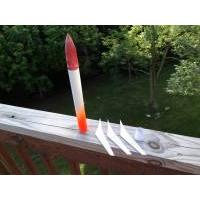
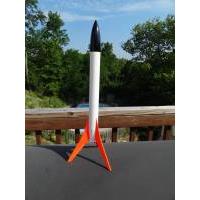
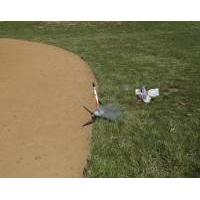
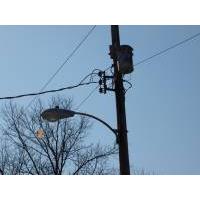
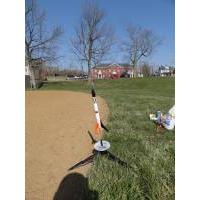












Ken Johnson (March 6, 2014)
One of my favorite kits from way back. Glad you got it back.